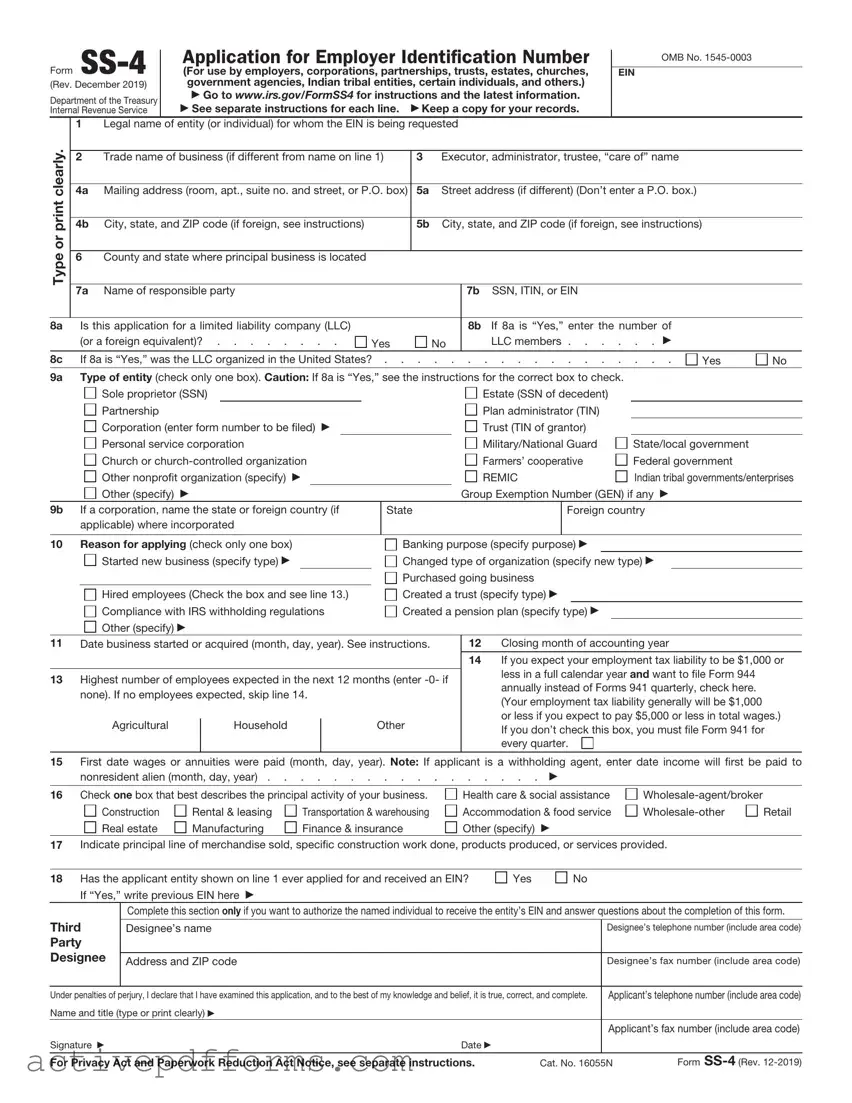IF the applicant... |
AND... |
THEN... |
|
|
|
started a new business |
doesn’t currently have (nor expect to have) |
complete lines 1, 2, 4a–8a, 8b–c (if applicable), 9a, |
|
employees |
9b (if applicable), and 10–14 and 16–18. |
|
|
|
hired (or will hire) employees, |
doesn’t already have an EIN |
complete lines 1, 2, 4a–6, 7a–b, 8a, |
including household employees |
|
8b–c (if applicable), 9a, 9b (if applicable), 10–18. |
|
|
|
opened a bank account |
needs an EIN for banking purposes only |
complete lines 1–5b, 7a–b, 8a, 8b–c |
|
|
(if applicable), 9a, 9b (if applicable), 10, and 18. |
|
|
|
changed type of organization |
either the legal character of the organization or its |
complete lines 1–18 (as applicable). |
|
ownership changed (for example, you incorporate a |
|
|
sole proprietorship or form a partnership)2 |
|
|
|
|
purchased a going business3 |
doesn’t already have an EIN |
complete lines 1–18 (as applicable). |
created a trust |
the trust is other than a grantor trust or an IRA |
complete lines 1–18 (as applicable). |
|
trust4 |
|
created a pension plan as a |
needs an EIN for reporting purposes |
complete lines 1, 3, 4a–5b, 7a–b, 9a, 10, and 18. |
plan administrator5 |
|
|
is a foreign person needing an |
needs an EIN to complete a Form W-8 (other than |
complete lines 1–5b, 7a–b (SSN or ITIN as applicable), |
EIN to comply with IRS |
Form W-8ECI), avoid withholding on portfolio assets, |
8a, 8b–c (if applicable), 9a, 9b (if applicable), 10, |
withholding regulations |
or claim tax treaty benefits6 |
and 18. |
|
|
|
is administering an estate |
needs an EIN to report estate income on Form 1041 |
complete lines 1–7b, 9a, 10–12, 13–17 (if applicable), |
|
|
and 18. |
|
|
|
is a withholding agent for |
is an agent, broker, fiduciary, manager, tenant, or |
complete lines 1, 2, 3 (if applicable), 4a–5b, 7a–b, 8a, |
taxes on nonwage income |
spouse who is required to file Form 1042, Annual |
8b–c (if applicable), 9a, 9b (if applicable), 10, and 18. |
paid to an alien (that is, |
Withholding Tax Return for U.S. Source Income of |
|
individual, corporation, or |
Foreign Persons |
|
partnership, etc.) |
|
|
|
|
|
is a state or local agency |
serves as a tax reporting agent for public assistance |
complete lines 1, 2, 4a–5b, 7a–b, 9a, 10, and 18. |
|
recipients under Rev. Proc. 80-4, 1980-1 C.B. 5817 |
|
|
|
|
is a single-member LLC (or |
needs an EIN to file Form 8832, Entity Classification |
complete lines 1–18 (as applicable). |
similar single-member entity) |
Election, for filing employment tax returns and excise |
|
|
tax returns, or for state reporting purposes8, or is a |
|
|
foreign-owned U.S. disregarded entity and needs an |
|
|
EIN to file Form 5472, Information Return of a 25% |
|
|
Foreign-Owned U.S. Corporation or a Foreign |
|
|
Corporation Engaged in a U.S. Trade or Business |
|
|
|
|
is an S corporation |
needs an EIN to file Form 2553, Election by a Small |
complete lines 1–18 (as applicable). |
|
Business Corporation9 |
|




